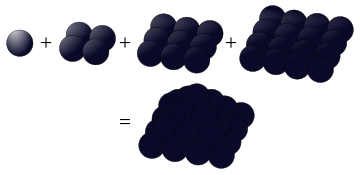
Geometric representation of the square pyramidal number 1+4+9+16=30.
In mathematics, a pyramid number, or square pyramidal number, is a figurate number that represents a pyramid with a base and four sides. These numbers can be expressed in a formula as
that is, by adding up the squares of the first n integers, or it was suggested that "by multiplying the nth pronic number by the nth odd number" you got the required result. But on further observation this is not true. By mathematical induction it is possible to derive one formula from the other. An equivalent formula is given in Fibonacci's Liber Abaci (1202, ch. II.12).
This is a special case of Faulhaber's formula.
The first few pyramid numbers are:
1, 5, 14, 30, 55, 91, 140, 204, 285, 385, 506, 650, 819
Pyramid numbers can be modelled in physical space with a given number of balls and a square frame that hold in place the number of balls forming the base, that is, n2. They also solve the problem of counting the number of squares in an n × n grid.
Relations to other figurate numbers[]
The pyramid numbers can also be expressed as sums of binomial coefficients (or of two consecutive tetrahedral numbers) thus:
We can derive another relation between square pyramidal numbers and tetrahedral numbers: if we let be the nth square pyramid number then
where is the nth tetrahedral number.
The sum of two consecutive square pyramidal numbers is an octahedral number.
Besides 1, there is only one other number that is both a square and a pyramid number, 4900, the 70th square number and the 24th square pyramidal number. This fact was proven by G. N. Watson in 1918.
Squares in a square[]
A common mathematical puzzle involves finding the number of squares in a large n by n square grid. This number can be derived as follows:
- The number of 1×1 boxes found in the grid is .
- The number of 2×2 boxes found in the grid is . These can be counted by counting all of the possible upper-left corners of 2×2 boxes.
- The number of k×k boxes (1 ≤ k ≤ n) found in the grid is . These can be counted by counting all of the possible upper-left corners of k×k boxes.
It follows that the number of squares in an n by n square grid is:
or:
That is, the solution to the puzzle is given by the square pyramidal numbers.
See also[]
References[]
- Abramowitz, M.; Stegun, I. A. (Eds.) (1964). Handbook of Mathematical Functions. National Bureau of Standards, Applied Math. Series 55. pp. 813. ISBN 0486612724.
- Beiler, A. H. (1964). Recreations in the Theory of Numbers. Dover. pp. 194. ISBN 0486210960.
- Template:Cite article
- Sigler, Laurence E. (trans.) (2002). Fibonacci's Liber Abaci. Springer-Verlag. pp. 260–261. ISBN 0-387-95419-8.
External links[]
- Weisstein, Eric W., "Square Pyramidal Number" from MathWorld.
cs:Pyramidové číslo
it:Numero piramidale quadrato
hu:Piramisszám
sl:Kvadratno piramidno število









